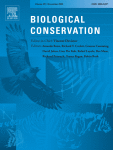Ver ítem
- xmlui.general.dspace_homeCentros e Institutos de InvestigaciónCIRN. Centro de Investigaciones de Recursos NaturalesInstituto de Recursos BiológicosArtículos científicosxmlui.ArtifactBrowser.ItemViewer.trail
- Inicio
- Centros e Institutos de Investigación
- CIRN. Centro de Investigaciones de Recursos Naturales
- Instituto de Recursos Biológicos
- Artículos científicos
- Ver ítem
Fading opportunities for mitigating agriculture-environment trade-offs in a south American deforestation hotspot
Resumen
Strong trade-offs between agriculture and the environment occur in deforestation frontiers, particularly in the world's rapidly disappearing tropical and subtropical dry forests. Pathways to mitigate these trade-offs are often unclear, as well as how deforestation or different policies alter the option space of available pathways. Using a spatial optimization framework based on linear programming, we develop a landscape-scale possibility frontier
[ver mas...]
Strong trade-offs between agriculture and the environment occur in deforestation frontiers, particularly in the world's rapidly disappearing tropical and subtropical dry forests. Pathways to mitigate these trade-offs are often unclear, as well as how deforestation or different policies alter the option space of available pathways. Using a spatial optimization framework based on linear programming, we develop a landscape-scale possibility frontier describing trade-offs between agricultural profit, biodiversity, and carbon stock for the Argentinean Dry Chaco, a global deforestation hotspot. We use this framework to assess how current land-use zoning, as well as past and future land-use-trajectories, alter the option space to minimize trade-offs between biodiversity, carbon, and agriculture. Our analyses yield four major insights. First, we found substantial co-benefits between biodiversity and carbon, yet strong trade-offs of both with agriculture. Second, development according to the current zoning could lead to highly suboptimal socio-ecological outcomes; our analysis pinpoints how this zoning could be improved. Third, high landscape-scale multifunctionality can be achieved using different land-use strategies, but maintaining >40% of forest is essential in all of them, and silvopasture systems appear to be central for achieving high overall multifunctionality. Finally, our results suggest the window of opportunity is closing rapidly: recent land-use changes since 2000 have rapidly moved the Chaco within the option space, with forest extent declining towards critical thresholds for maintaining balanced, multifunctional landscapes. Our results emphasize that the time for sustainability planning in the Chaco is now. More broadly, we show how multi-criteria optimization can describe dynamic trade-offs between agriculture and the environment at landscape and regional scales. This can help to identify land-system tipping points that, once crossed, would inhibit more sustainable futures, and policies to avoid such potential traps.
[Cerrar]

Autor
Law, Elizabeth A.;
Macchi, Leandro;
Baumann, Mathias;
Decarre, Julieta;
Gavier Pizarro, Gregorio Ignacio;
Levers, Christian;
Mastrangelo, Matías Enrique;
Murray, Francisco;
Müller, Daniel;
Piquer‐Rodriguez, María;
Torres, Ricardo;
Wilson, Kerrie A.;
Kuemmerle, Tobias;
Fuente
Biological Conservation 262 : 109310 (October 2021)
Fecha
2021-10
Editorial
Elsevier
ISSN
0006-3207
Formato
pdf
Tipo de documento
artículo
Palabras Claves
Derechos de acceso
Abierto
 Excepto donde se diga explicitamente, este item se publica bajo la siguiente descripción: Creative Commons Attribution-NonCommercial-ShareAlike 2.5 Unported (CC BY-NC-SA 2.5)
Excepto donde se diga explicitamente, este item se publica bajo la siguiente descripción: Creative Commons Attribution-NonCommercial-ShareAlike 2.5 Unported (CC BY-NC-SA 2.5)


